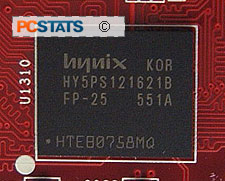 As you
know, nVidia's GeForce 7300GS core is built on TSMC's trendy 0.09 micron
manufacturing process. This makes the Geforce 7300GS one of nVIDIA's first 90nm
parts.
As you
know, nVidia's GeForce 7300GS core is built on TSMC's trendy 0.09 micron
manufacturing process. This makes the Geforce 7300GS one of nVIDIA's first 90nm
parts.
Like the GeForce 6200TC
GPU that came before it, the Geforce 7300GS supports nVIDIA's 'TurboCache'
technology. What that does is allow the videocard to use system memory
to store graphics data - so basically this PCI Express graphics card can
appropriate up to 256MB of memory away from Microsoft Windows XP for its own
use.
There are a two different flavours of GeForce 7300GS videocards
available, a 128MB model and a 256MB version (we're reviewing the 256MB
model). The 128MB version will gobble up another 128MB of system
memory to use as its own for a total of 256MB of graphics memory. The
256MB version will take up to another 256MB, giving it a total of 512MB of
memory to access.
Because memory bandwidth is a key
issue, the memory controller on nVidia GeForce 7300GS videocards has been upgraded
to 64-bits. Some earlier GeForce 6200TC videocards utilized a 32 bit memory controller, that
severely crippled 3D performance.
The biggest change between nVidia GeForce 6200TC and the GeForce 7300GS CPUs is
clock speed. The new core is clocked at 550 MHz, with memory at 350 MHz. The
vertex pipelines have remained the same at 3, and pixel pipeline at 4.
nVIDIA
PureVideo
High Definition content is the future of entertainment!
Playing High Definition content on current generation PCs can bog down the
fastest processors because there is more data to handle. Similar to the need for
DVD accelerators a few years back, nVIDIA PureVideo enables computer users to
view MPEG-2/DVD and WMV HD formats without slowing the PC to a crawl.
The PureVideo standard incorporates a hardware
accelerator for the afore mentioned MPEG-2/DVD, and Microsoft Windows Media HD
Video standards (WMV HD). According to nVIDIA's documentation on PureVideo, the
GPU (GeForce 6 and 7 series GPUs) takes on video decoding tasks from the CPU,
and the end result is smoother, shutter free HD playback. nVIDIA PureVideo also
supports most current and future high definition formats. The system seems to be
built with a good degree of future proofing for upcoming standards - as it
should be.
PureVideo is more than just a media accelerator; it also
includes features to improve video picture quality. If you believe the
marketing; DVD, cable, and satellite video provide poor crispness, clearness and
smoothness that consumers are desperate to be "saved from." nVIDIA's PureVideo
technology applies spatial temporal de-interlacing to apparently deliver a
better image than traditional de-interlacing can muster. PureVideo also fixes
the 3:2 pull down problem that can arise from 24 fps video being converted to 30
fps for viewing on TVs or monitors. By recovering the original 24 frame content,
PureVideo apparently allows for a clear crisper image.
PureVideo can also scale videos to any resolution, while
maintaining a relatively detailed picture. This means users can view lower
resolution videos at a high resolution without suffering too much from blocky or
blurry pictures.
To test PureVideo's HD accelerating capabilities, we
decided to play one video through Windows Media Player 10, which was downloaded
from Microsoft's WMV HD Content Showcase. The
Discoverers (IMAX) video is available in both 720P and 1080P formats, and CPU
utilization was monitored through Task Manager to give a general indication of
system load.

Running the 720P version of "The Discoverers" video, CPU usage
hovered between 22% and 38%.

The 1080P version of
"The Discoverers" video obviously uses more system resources. CPU usage jumps between 36% and
44%. It's a bit on the high side, but then again you're probably not going to be burning a
DVD while watching a high definition video so it should be sufficient.
Now, let's have a look at the test system specs, answer the
question of overclocking, and dive right into the benchmarks!
